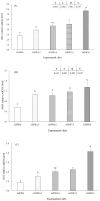Evaluation of Garlic Juice Processing Waste Supplementation in Juvenile Black Rockfish (Sebastes schlegelii) Diets on Growth Performance, Antioxidant and Digestive Enzyme Activity, Growth- and Antioxidant-Related Gene Expression, and Disease Resistance against Streptococcus iniae
- PMID: 36552431
- PMCID: PMC9774645
- DOI: 10.3390/ani12243512
Evaluation of Garlic Juice Processing Waste Supplementation in Juvenile Black Rockfish (Sebastes schlegelii) Diets on Growth Performance, Antioxidant and Digestive Enzyme Activity, Growth- and Antioxidant-Related Gene Expression, and Disease Resistance against Streptococcus iniae
Abstract
An 8-week feeding trial was conducted to evaluate the effects of various dietary levels of garlic juice processing waste (GJPW) on the growth, feed utilization, digestive and antioxidant enzyme activity, growth- and antioxidant-related gene expression, and resistance to Streptococcus iniae infection of juvenile black rockfish (Sebastes schlegelii). A total of 450 juvenile rockfish were randomly distributed into 30 L rectangular tanks (30 fish per tank). Five experimental diets were prepared in triplicate. The fish were fed experimental diets supplemented with GJPW at concentrations of 0 (GJPW0, control), 2.5 (GJPW2.5), 5 (GJPW5), 7.5 (GJPW7.5), and 10 g kg-1 (GJPW10) diet. All of the GJPW-supplemented treatments (2.5, 5, 7.5, and 10 g kg-1) significantly enhanced weight gain (WG), specific growth rate (SGR), feed efficiency (FE), protein efficiency ratio (PER), and digestive enzyme activity (amylase, trypsin, and lipase). A decreasing trend was seen in plasma aspartate aminotransferase (ALT), alanine aminotransferase (AST), and glucose (GLU) content with increasing dietary levels of GJPW. In contrast, plasma lysozyme and antioxidant enzyme activities were significantly increased with increasing dietary GJPW levels. Furthermore, GJPW administration significantly upregulated the expression of insulin-like growth factor-1 (IGF-1), superoxide dismutase (SOD), catalase (CAT), and glutathione S-transferase (GST) in the liver of rockfish. A challenge test with S. iniae showed significantly higher resistance in the GJPW-supplemented treatments than in the control. In short, dietary supplementation GJPW enhanced growth performance and antioxidant response in juvenile black rockfish, with suitable effects in fish fed with 2.5 g kg-1 GJPW for 8 weeks.
Keywords: antioxidant response; black rockfish (Sebastes schlegelii); digestive enzyme; disease resistance; garlic juice processing waste (GJPW); growth performance.
Conflict of interest statement
The authors declare no conflict of interest.
Figures



Similar articles
-
Blood Orange (Citrus sinensis L. Osbeck) Juice By-Product Extract as a Functional Feed Additive: Effects on Growth Performance, Digestive Enzyme Activity, Antioxidant Status, Immune Parameters, and Disease Resistance Against Vibrio harveyi in Juvenile Black Rockfish (Sebastes schlegelii).Antioxidants (Basel). 2025 Jun 17;14(6):745. doi: 10.3390/antiox14060745. Antioxidants (Basel). 2025. PMID: 40563377 Free PMC article.
-
Dietary Supplementation with Ginger (Zingiber officinale) Residue from Juice Extraction Improves Juvenile Black Rockfish (Sebastes schlegelii) Growth Performance, Antioxidant Enzyme Activity and Resistance to Streptococcus iniae Infection.Animals (Basel). 2022 Feb 22;12(5):546. doi: 10.3390/ani12050546. Animals (Basel). 2022. PMID: 35268115 Free PMC article.
-
Effect of Blood Orange (Citrus sinensis L. Osbeck) Peel Waste as a Feed Additive on the Growth Performance, Digestive Enzyme Activity, Antioxidant Capacity, and Immune Response in Juvenile Black Rockfish (Sebastes schlegelii).Antioxidants (Basel). 2024 Nov 26;13(12):1452. doi: 10.3390/antiox13121452. Antioxidants (Basel). 2024. PMID: 39765781 Free PMC article.
-
Impacts of Replacing Blended Fish Meal With Diverse Animal and Plant Protein Sources and Their Combinations in the Diets on Growth, Feed Availability, Biochemical Composition, and Blood Chemistry of Rockfish (Sebastes schlegelii).Aquac Nutr. 2025 Feb 27;2025:5625045. doi: 10.1155/anu/5625045. eCollection 2025. Aquac Nutr. 2025. PMID: 40051437 Free PMC article.
-
Replacement of fish oil with palm oil: Effects on growth performance, innate immune response, antioxidant capacity and disease resistance in Nile tilapia (Oreochromis niloticus).PLoS One. 2018 Apr 25;13(4):e0196100. doi: 10.1371/journal.pone.0196100. eCollection 2018. PLoS One. 2018. PMID: 29694393 Free PMC article.
Cited by
-
Blood Orange (Citrus sinensis L. Osbeck) Juice By-Product Extract as a Functional Feed Additive: Effects on Growth Performance, Digestive Enzyme Activity, Antioxidant Status, Immune Parameters, and Disease Resistance Against Vibrio harveyi in Juvenile Black Rockfish (Sebastes schlegelii).Antioxidants (Basel). 2025 Jun 17;14(6):745. doi: 10.3390/antiox14060745. Antioxidants (Basel). 2025. PMID: 40563377 Free PMC article.
References
-
- Mostafavi Z.S.M., Shekarabi S.P.H., Mehrgan M.S., Islami H.R. Amelioration of growth performance, physio-metabolic responses, and antioxidant defense system in rainbow trout, Oncorhynchus mykiss, using dietary dandelion, Taraxacum officinale, flower extract. Aquaculture. 2022;546:737296. doi: 10.1016/j.aquaculture.2021.737296. - DOI
-
- Paknejad H., Shekarabi S.P.H., Mehrgan M.S., Hajimoradloo A., Khorshidi Z., Rastegari S. Dietary peppermint (Mentha piperita) powder affects growth performance, hematological indices, skin mucosal immune parameters, and expression of growth and stress-related genes in Caspian roach (Rutilus caspicus) Fish Physiol. Biochem. 2020;46:1889–1895. doi: 10.1007/s10695-020-00839-z. - DOI - PubMed
-
- Srichaiyo N., Tonhsiri S., Hoseinifar S.H., Dawood M.A.O., Jaturasitha S., Esteba M.Á., Ringø E., Van Ooan H. The effects gotu kola (Centella asiatica) powder on growth performance, skin mucus, and serum immunity of Nile tilapia (Oreochromis niloticus) fingerlings. Aquac. Rep. 2020;16:100239. doi: 10.1016/j.aqrep.2019.100239. - DOI
-
- Chung S., Ribeiro K., Melo J.F.B., Teixeira D.V., Vidal L.V.O., Copatti C.E. Essential oil from ginger influences the growth, haematological and biochemical variables and histomorphometry of intestine and liver of Nile tilapia juveniles. Aquaculture. 2021;534:36325. doi: 10.1016/j.aquaculture.2020.736325. - DOI
Grants and funding
LinkOut - more resources
Full Text Sources
Research Materials
Miscellaneous

